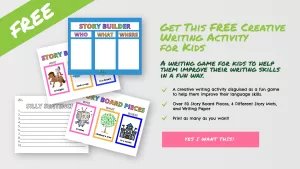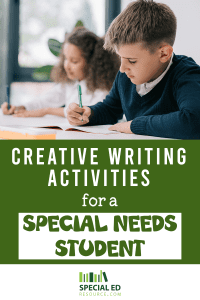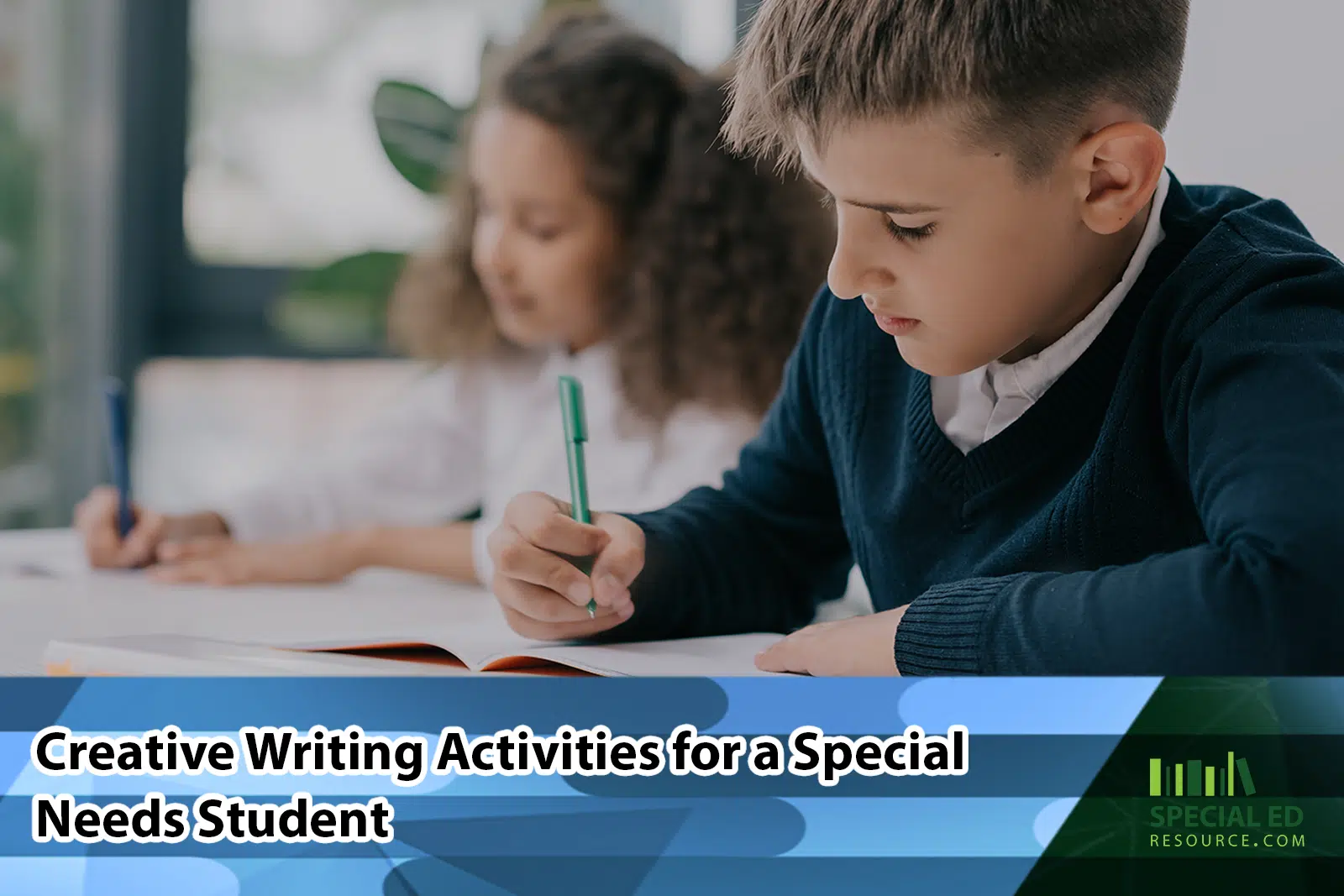I always assigned creative writing activities on the first day of school to start the year off on the right foot. For instance, I wanted the students to share something from their Summer vacation right after lunch this particular school year.
However, one of my students had a hard time with the assignment.
“I can’t do this!” John said, slamming his pencil down. “These writing assignments are just too hard for me,” he continued.
“What is it about the assignment that makes it too hard for you, John,” I said.
“I’m just not good at writing, and I don’t know what to write about,” John said.
Writing is one of the hardest tasks for children who have special needs. The process of getting their thoughts and ideas down on paper is overwhelming for students.
Creative Writing Activities for a Special Needs Student
Although writing can be a tedious process, there are many different ways for students to express themselves through writing. Here are eleven great writing activities to try with your students.
11 Writing Activities Your Special Needs Students Will Enjoy
#1 Comic Book Writing
I have found that some of my students love writing comic book stories. They don’t feel overwhelmed like they do when they are assigned a five-paragraph essay. In addition, it is a creative way to practice writing in smaller sentences.
You can find comic book-creating websites or templates online to help you plan the assignment. I have found that Make Beliefs Comix is a great online resource for those wanting to explore and write creatively. I have a student who uses this website, and he loves being able to create his own comic book.
#2 Sensory Writing
Sensory writing is an engaging way to encourage students to use all of their senses in their writing.
Begin by offering your students a variety of sensory experiences, such as:
- Smelling different scents
- Touching various textures
- Listening to different sounds
- Looking at things in different ways, like under a microscope, magnifying glass, or in the dark with a flashlight
Then, have them describe these experiences using vivid language and detail. Sensory writing activities help students to develop their descriptive writing skills and connect their experiences to their writing.
#3 Memory Writing
Memory writing is an activity where students can reflect on something they read earlier in the week. The reading could be something that they read or experienced in reading groups.
The students have a time limit to reflect and write so that everyone has an opportunity to write about what they remember. This creative writing activity is important because it encourages students to recall their memories, which builds stronger connections in the brain.
#4 Reading Response Journals
As a student, I hated work that seemed like a waste of time. One thing that I remember was that each week we had to write a reading response about something that we had read that week.
A reading response journal is a series of entries from students’ reflections, opinions, and reactions to readings. This active learning technique encourages them to examine things thoroughly and relate what they’ve read to their prior knowledge and experiences.
Tips for Reading Response Journals
- Let your student know this is his journal. No one else has to read it, and he will not be graded on what he writes in it.
- Give ample time for each student to write in their journal immediately after reading time when it is fresh on their mind.
- Provide journal prompts so your students aren’t sitting there staring at the blank page, overwhelmed with what to write. Here are a couple of reading response journal prompts:
#5 Picture Storytelling
Visual aids can be a powerful tool to engage special needs students in creative writing. Provide your students with a selection of interesting images, such as landscapes, animals, or scenes from everyday life.
Encourage them to choose one image and write a short story based on what they see. This activity allows students to practice their descriptive writing skills while simultaneously stimulating their imagination.

#6 Group Storytelling
Group storytelling is a collaborative and interactive way to help your students practice their writing skills.
First, divide your students into small groups and give each group a story prompt or a sentence to start with. Then, have each student take turns adding a sentence or two to the story.
This activity helps students learn to work together, practice writing coherent narratives, and develop their listening skills.
#7 Sentence Structure Writing Activities
There are many ways to practice writing skills. However, as a teacher, I always think of ways to get my students to work on their sentence structure that is not so boring or overwhelming.
Ideas for Practicing Sentence Structure
-
- Give them a topic that they have to write about in under 100 words.
- Provide them one word to write a paragraph about what they know about that word.
- Give them unique writing prompts that could have fun and creative endings. For example, “If they were to have a dinosaur for a pet, what would they do with their dinosaur?”
- Have them map out an outline of their paper using a specific topic.
- Do a brainstorming activity using their research topic.
#8 Mad Libs
Mad Libs is an activity that helps students practice their grammar and vocabulary skills in a fun way without pressure.
Create a simple story template with blanks for various parts of speech (nouns, verbs, adjectives, etc.). Have your students fill in the blanks with their own choices of words.
When they’re done, read the completed Mad Libs story aloud, and enjoy the silly and creative results!
#9 Letter Writing
Letter writing can be an enjoyable way for students to practice their writing and communication skills. Encourage students to write letters to friends, family members, or even fictional characters.
Teach them about the different parts of a letter, such as the greeting, body, and closing. Letter writing helps students practice organizing their thoughts, expressing their feelings, and writing in a clear and structured manner.
You can even check out these pen pal programs for kids to write to astronauts, authors, and deployed soldiers.
#10 What If” Scenarios
Encourage your special needs students to think outside the box by presenting them with “what if” scenarios. Provide prompts that ask students to imagine alternate realities or situations, such as “What if…”
-
You could become invisible for a day?
Prompt students to consider how they would spend their day, what challenges they might face, and how they would use their newfound ability to help others or create positive change.
-
The world was made of candy?
Encourage students to describe the landscape, the different types of candy they would encounter, and how daily life would be affected by this sweet environment.
-
You discovered a secret door in your house that led to a magical land?
Ask students to describe the magical land, its inhabitants, and the adventures they would embark on during their visit.
-
Technology suddenly ceased to exist?
Have students consider how their lives would change, how people would communicate, and how society would adapt to a world without technology.
-
Everyone had the power to fly?
Invite students to describe how transportation, sports, and daily life would be transformed if everyone had the ability to fly.
-
You could communicate with animals?
Prompt students to imagine conversations they would have with animals, how they would use this skill to help them, and what they might learn from these interactions.
-
There was a potion that could grant any three wishes?
Encourage students to consider what wishes they would make, the consequences of their wishes, and how their lives and the world around them would change.
-
Humans could breathe underwater?
Have students explore the idea of a world where people could live both on land and underwater, describing new cities, societies, and discoveries that might emerge in this alternate reality.
-
Time could be paused for an hour each day?
Invite students to consider how they would use that extra hour, how it would affect their daily routine and the potential benefits or drawbacks of this newfound ability.
-
You found a map to a hidden treasure?
Ask students to describe the journey they would take to find the treasure, the obstacles they would encounter, and what they would do with the treasure once they found it.
Have your students write a short story or paragraph describing the scenario and its consequences. This activity fosters creativity and helps students explore new perspectives and ideas in their writing.
You could make this a What if Wednesday activity that your students would look forward to each week.
#11 Rewrite
Lastly, another creative writing activity that is fun and gets children to think creatively is something I call “rewrite.”
Many stories over the years have been rewritten with new endings. For example, Cinderella is a story that has multiple different endings.
Give students a short story to rewrite that would change the story in some way. This assignment can be an excellent writing activity to teach them about plagiarism. In addition, you can instruct them on the best way to write the story without copying the author’s ideas or information.
What Creative Writing Activities Do You Use In Your Classroom?
Writing can be difficult for special needs students. However, creative writing activities can be a fun way for students to learn the basics of writing. Choose from any one of these five writing exercises, or try them all!
No matter which you choose, we’re confident that they will help your student develop their language skills in ways that are both enjoyable and challenging.
Do you have an idea for another creative exercise or activity not listed here? Drop it in the comments below so we can add it to our list. We look forward to hearing how this helps your students!
Additional Resources
- Writing Strategies Made Simple
- How to Easily Create Social Stories to Successfully Teach Children
- Reading And Writing Our Way Through Thanksgiving
Get weekly tips and techniques from a fellow Special Educator and parent of a special needs child.
Do you have a student that needs one-on-one special education tutoring that can be done from anywhere? Our special education experts conduct their sessions online! Get them started with a free consultation!






